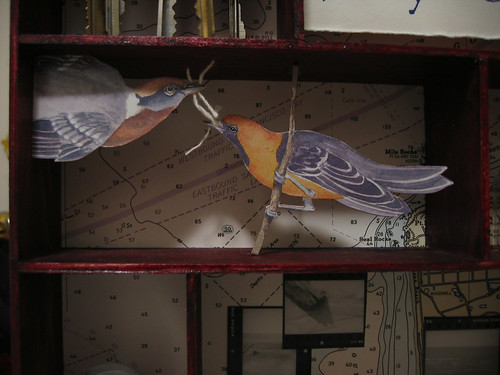
{Photo by rocketlass of a box by rocketlass.}
A couple of years after first my first, admittedly desultory attempt to read Harry Stephen Keeler, I've dived right into one of his biggest and strangest books, The Box from Japan (1932), a volume that even committed Keelerite Ed Park describes as "WEIRD." He's right, but through at least the first fifty pages, The Box from Japan's weirdness is charming, consisting mostly of exuberance, exclamation points, and unusual descriptions that resemble nothing so much as particularly enthusiastic advertising copy.
Like many (or all?) of Keeler's novels, The Box from Japan is set in his native Chicago, "that London of the West"--though in 1942, an eventful ten years into the future. The most striking thing so far about Keeler's past-future Chicago is not its robotic policemen or skyscraper landing strips for airplanes . . . no, sadly, it's this:
His little two-block jump, it is true, cost him a red 25-cent coupon out of his perforated book of taxi-meter "pay" tickets, but saved him perhaps some ten minutes of elbowing his way along a thoroughfare which now, in Chicago, connecting as it did the busiest stations of the venerable old State Street subway and the new Clark Street subway, was hopelessly crowded at this hour of the morning.Oh, if only Chicago really had a Clark Street subway--hell, if only we had any serious expansion of the coverage of our subway system, or if only we weren't relying on technology nearly as old as Keeler's book. Our terrible transit system is not helping kill my current crush on New York.
But it seems wrong to leave you with a lament. Instead, I'll share the most striking non-Chicago-related line in the first fifty pages of The Box from Japan. To set it up I have to transcribe a description that precedes it. The scene is the office of the American Projectiscope Company, Inc.:
Near the door, however--and Carr Halsey smiled in spite of himself--was a movable polished wooden railing as venerable as those others like it which adorned all offices when he had been but small boy, and he knew at least that he was in the right place, for this was but one of the many relics which his uncle lovingly transported from office to office as the American Projectiscope Company every few years changed its quarters.Keeler then describes the sentry of the inner office door:
And guarding the one opening in the antique wooden railing, moreover, sat Babson, more venerable appendage of the American Projectiscope Company than any single piece of office furniture it might own! Elderly, with rapidly thinning gray hair, he was, beyond all doubt, even more like that wooden railing than the railing itself!"Even more like that wooden railing than the railing itself"? I know what Keeler means, but what he's actually written makes no sense! And is impossible to forget once you've read it!
I think I'm going to start using that method of comparison in my daily life. For example: in his use of exclamation points, Ed Park frequently is even more like Harry Stephen Keeler than Harry Stephen Keeler himself!
Here in the real world, the State Street subway didn't even open until 1943!
ReplyDeleteThe Kelker Plan of 1923 actually did call for a Clark-Broadway subway line, among many others. If only...
Jim Ellwanger is even more like the history of the CTA than the history of the CTA itself!
ReplyDelete